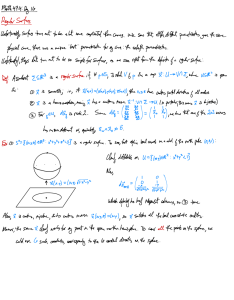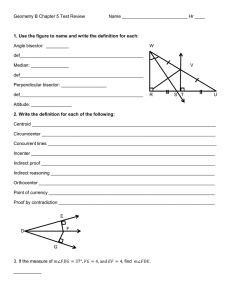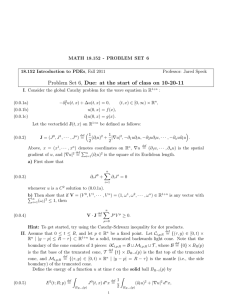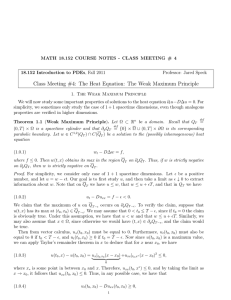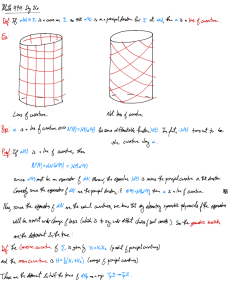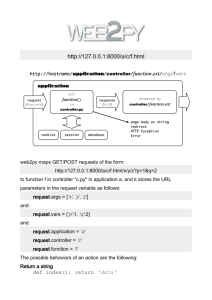Problem Set 6, Due: at the start of class on...
advertisement
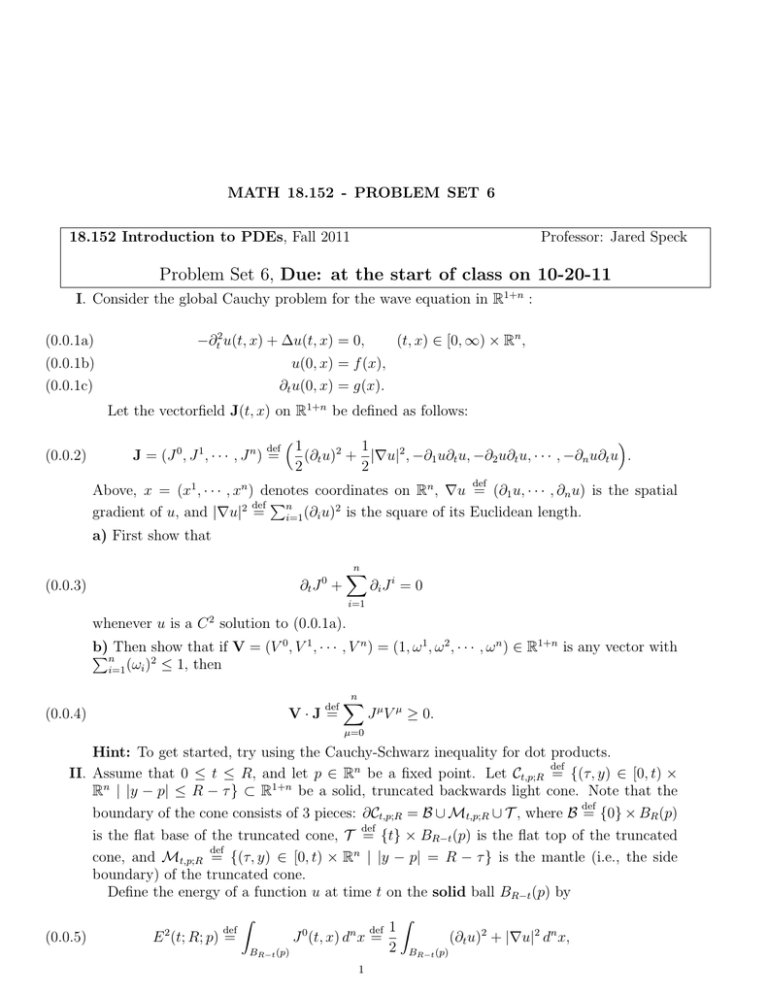
MATH 18.152 - PROBLEM SET 6
18.152 Introduction to PDEs, Fall 2011
Professor: Jared Speck
Problem Set 6, Due: at the start of class on 10-20-11
I. Consider the global Cauchy problem for the wave equation in R1+n :
(t, x) ∈ [0, ∞) × Rn ,
−∂t2 u(t, x) + ∆u(t, x) = 0,
(0.0.1a)
(0.0.1b)
u(0, x) = f (x),
(0.0.1c)
∂t u(0, x) = g(x).
Let the vectorfield J(t, x) on R1+n be defined as follows:
(0.0.2)
def
J = (J 0 , J 1 , · · · , J n ) =
1
1
(∂t u)2 + |∇u|2 , −∂1 u∂t u, −∂2 u∂t u, · · · , −∂n u∂t u .
2
2
def
Above, x = (x1 , · · · , xn ) denotes coordinates on Rn , ∇u = (∂1 u, · · · , ∂n u) is the spatial
def P
gradient of u, and |∇u|2 = ni=1 (∂i u)2 is the square of its Euclidean length.
a) First show that
0
(0.0.3)
∂t J +
n
X
∂i J i = 0
i=1
2
whenever u is a C solution to (0.0.1a).
0
1
n
1
2
n
1+n
b)
is any vector with
PnThen 2show that if V = (V , V , · · · , V ) = (1, ω , ω , · · · , ω ) ∈ R
i=1 (ωi ) ≤ 1, then
def
V·J =
(0.0.4)
n
X
J µ V µ ≥ 0.
µ=0
Hint: To get started, try using the Cauchy-Schwarz inequality for dot products.
def
II. Assume that 0 ≤ t ≤ R, and let p ∈ Rn be a fixed point. Let Ct,p;R = {(τ, y) ∈ [0, t) ×
Rn | |y − p| ≤ R − τ } ⊂ R1+n be a solid, truncated backwards light cone. Note that the
def
boundary of the cone consists of 3 pieces: ∂Ct,p;R = B ∪ Mt,p;R ∪ T , where B = {0} × BR (p)
def
is the flat base of the truncated cone, T = {t} × BR−t (p) is the flat top of the truncated
def
cone, and Mt,p;R = {(τ, y) ∈ [0, t) × Rn | |y − p| = R − τ } is the mantle (i.e., the side
boundary) of the truncated cone.
Define the energy of a function u at time t on the solid ball BR−t (p) by
(0.0.5)
Z
1
E (t; R; p) =
J (t, x) d x =
2
BR−t (p)
2
def
0
def
n
1
Z
BR−t (p)
(∂t u)2 + |∇u|2 dn x,
2
MATH 18.152 - PROBLEM SET 6
and recall that the divergence theorem in R1+n implies that
Z
0
(0.0.6)
∂t J +
Ct,p;R
n
X
!
∂i J
i
Z
n
Z
N(σ) · J dσ −
d xdt =
Mt,p;R
i=1
0
n
Z
J d x+
J 0 dn x .
B (p)
B
(p)
| R {z
} | R−t {z
}
E 2 (0;R;p)
E 2 (t;R;p)
In (0.0.6), N(σ) is the unit outward normal to Mt,p;R .
Remark 0.0.1. In the near future, we will discuss the geometry of Minkowski spacetime,
which is intimately connected to the linear wave equation. Our study will lead to a geometrically motivated construction of the vectorfield J and the identity (0.0.6). Alternatively,
the identity (0.0.6) could also be derived by multiplying both sides of equation (0.0.1a) by
−∂t u, then integrating by parts and using the divergence theorem.
a) Show that the unit outward normal N(σ) to Mt,p;R is of the form
(0.0.7)
1
N(σ) = √ 1, ω 1 (σ), ω 2 (σ), · · · , ω n (σ) ,
2
Pn
i 2
where i=1 (ω ) = 1. Note that by translational invariance, you may assume that p = 0.
b) With the help of Problem I and (0.0.6) - (0.0.7), show that if u is a C 2 solution to
(0.0.1a), then
E 2 (t; R; p) ≤ E 2 (0; R; p)
(0.0.8)
holds for all t with 0 ≤ t ≤ R.
c) Then show that if the functions f (x) and g(x) from (0.0.1b) - (0.0.1c) are both smooth
and vanish outside of the ball BR0 (p) ⊂ Rn , then at each time t ≥ 0, the solution u(t, x) to
(0.0.1a) vanishes outside of the ball BR0 +t (p).
d) Finally, under the same assumptions on f and g, let R → ∞ in (0.0.8) (and also use
additional arguments) to show that the solution u to (0.0.1a) satisfies
(0.0.9)
def
Z
k|∇t,x u(t, ·)|kL2 (Rn ) = k|∇t,x u(0, ·)|kL2 (Rn ) =
2
2
n
|g(x)| + |∇f (x)| d x
1/2
,
Rn
def p
where ∇t,x u = (∂t u, ∂1 , · · · , ∂n u) is the spacetime gradient of u, |∇t,x u| = (∂t u)2 + (∂1 u)2 + · · · (∂n u)2 ,
and the L2 norms in (0.0.9) are taken over the spatial variables only.
def
III. Let R > 0, and let f (x), g(x) be smooth functions on R that vanish outside of BR (0) =
[−R, R]. Let u(t, x) be the corresponding unique solution to the following global Cauchy
problem on R1+1 :
(0.0.10a)
−∂t2 u(t, x) + ∂x2 u(t, x) = 0,
(0.0.10b)
u(0, x) = f (x),
(0.0.10c)
∂t u(0, x) = g(x).
We define the following quantities:
MATH 18.152 - PROBLEM SET 6
(0.0.11a)
(0.0.11b)
2
def
Z
def
ZR
P (t) =
K 2 (t) =
2
∂x u(t, x) dx,
the potential energy
2
∂t u(t, x) dx,
the kinetic energy
3
R
(0.0.11c)
def
E 2 (t) = P 2 (t) + K 2 (t),
the total energy.
In Problem II, you used energy methods to prove that E(t) is conserved: E(t) = E(0) for
all t ≥ 0. Now show that if t is large enough, then P 2 (t) = K 2 (t) = 21 E 2 (t). This is called
the equipartitioning of the energy.
Hint: Try expressing P (t) and K(t) in terms of the null derivatives ∂q u(t, x) and ∂s u(t, x)
that we used in the proof of d’Alembert’s formula. If you set up the calculations
properly,
R
then the desired equipartitioning result should boil down to proving that R (∂q u(t, x))(∂s u(t, x)) dx =
0 for all large t. In order to prove this latter result, take a close look at the the expressions
for ∂q u(t, x) and ∂s u(t, x) that we derived in terms of f, g during that proof, and make use
of the assumptions on f, g.
MIT OpenCourseWare
http://ocw.mit.edu
18.152 Introduction to Partial Differential Equations.
Fall 2011
For information about citing these materials or our Terms of Use, visit: http://ocw.mit.edu/terms.
